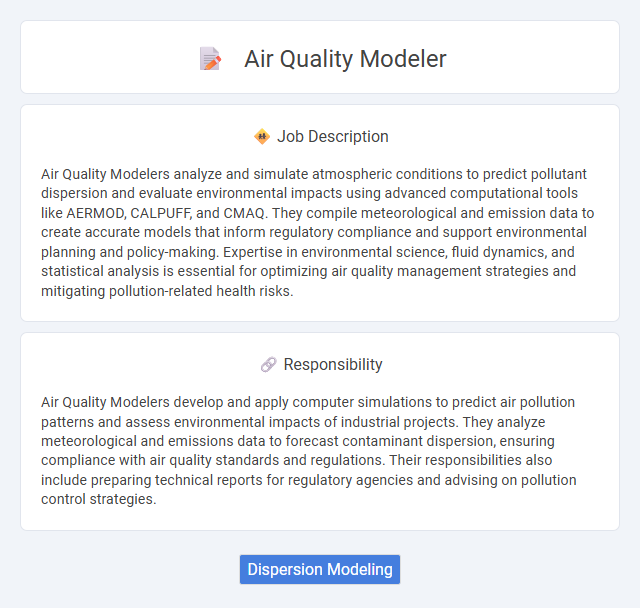
Air Quality Modelers analyze and simulate atmospheric conditions to predict pollutant dispersion and evaluate environmental impacts using advanced computational tools like AERMOD, CALPUFF, and CMAQ. They compile meteorological and emission data to create accurate models that inform regulatory compliance and support environmental planning and policy-making. Expertise in environmental science, fluid dynamics, and statistical analysis is essential for optimizing air quality management strategies and mitigating pollution-related health risks.
Individuals with strong analytical skills and a passion for environmental science are likely to find the Air Quality Modeler role suitable. Those comfortable working with complex data sets and computer models may have a higher probability of succeeding in this position. Candidates lacking interest in technical problem-solving or attention to detail might find this job less fitting for their strengths.
Qualification
Air Quality Modeler jobs require a strong foundation in environmental science, atmospheric chemistry, and advanced proficiency in air dispersion modeling software such as AERMOD, CALPUFF, or CMAQ. Candidates typically hold a bachelor's or master's degree in environmental engineering, atmospheric science, or a related field, complemented by experience in data analysis, regulatory compliance, and emissions inventory development. Expertise in Geographic Information Systems (GIS), statistical software, and familiarity with EPA air quality standards enhance qualification strength in this role.
Responsibility
Air Quality Modelers develop and apply computer simulations to predict air pollution patterns and assess environmental impacts of industrial projects. They analyze meteorological and emissions data to forecast contaminant dispersion, ensuring compliance with air quality standards and regulations. Their responsibilities also include preparing technical reports for regulatory agencies and advising on pollution control strategies.
Benefit
Air Quality Modeler positions likely offer the benefit of contributing to environmental protection by predicting pollutant dispersion and helping design better air quality management strategies. The role probably provides opportunities for skill development in advanced modeling software and data analysis techniques. Employees may experience job satisfaction from influencing public health policies and promoting sustainable practices.
Challenge
Air Quality Modeler roles likely involve complex challenges such as accurately predicting pollutant dispersion under varying meteorological conditions, which requires advanced knowledge of atmospheric science and modeling software. The need to balance model precision with computational efficiency can pose significant difficulties, especially when dealing with large datasets and evolving environmental regulations. Professionals might frequently face the challenge of integrating diverse data sources to produce reliable air quality forecasts that inform public health and policy decisions.
Career Advancement
Air Quality Modelers leverage expertise in atmospheric science and computer modeling to assess pollution impacts and develop strategies for environmental compliance, making them key contributors in environmental consultancy and regulatory agencies. Mastery of advanced modeling software, data analysis, and environmental regulations drives career growth from entry-level analyst positions to senior scientist or project manager roles. Pursuing certifications such as the Certified Air Quality Specialist (CAQS) and gaining experience with EPA-approved models like AERMOD or CALPUFF significantly enhances opportunities for leadership and specialized consultancy careers.
Key Terms
Dispersion Modeling
Air Quality Modelers specializing in Dispersion Modeling analyze pollutant distribution patterns to predict air contaminant concentrations using advanced software such as AERMOD or CALPUFF. They apply atmospheric data, emission sources, and meteorological conditions to simulate how pollutants disperse over time and geographical areas, ensuring compliance with environmental regulations. Their expertise supports environmental impact assessments, air quality management plans, and health risk evaluations by providing accurate dispersion forecasts.
 kuljobs.com
kuljobs.com